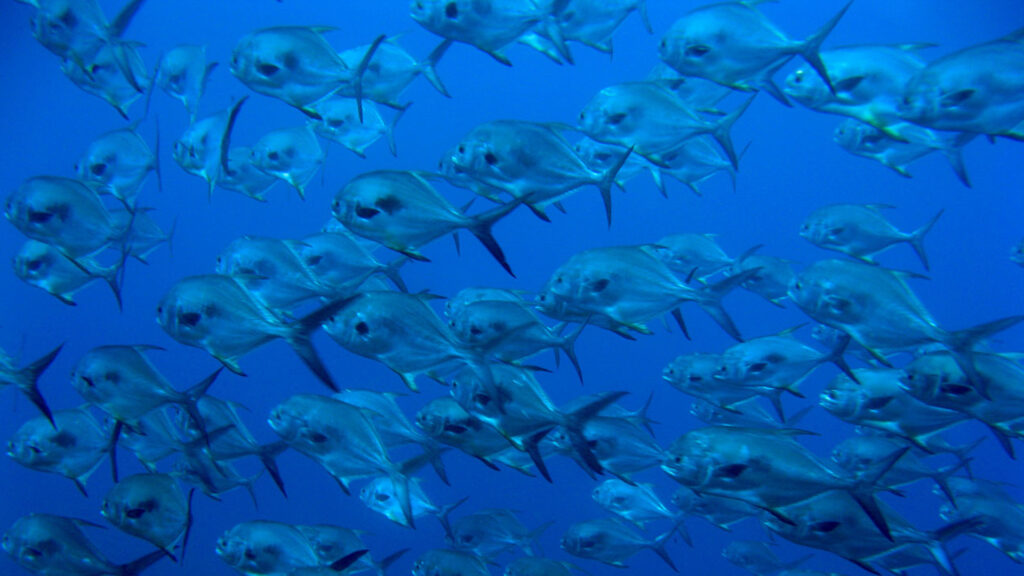By Robert C. Jones Jr., University of Miami
It’s the perfect fuel for storms: warm ocean water, at least 80 degrees Fahrenheit. Without it, powerful storms like Andrew, Katrina and Ian would never have formed.
But for certain fish that ply the waters of the world’s oceans, exceptionally high ocean temperatures can be a death knell, decreasing the levels of dissolved oxygen in the sea they need to survive.

And this year, the Atlantic Ocean and Gulf of Mexico are warmer than they have ever been on record, with water temperatures in the latter topping 88 degrees during one week in August.
Scientists at the National Oceanic and Atmospheric Administration have been tracking a steady uptick in ocean temperatures since April, and thousands of dead fish have washed ashore in Florida coastal areas — from Hallandale Beach to the Tampa Bay area — and along the Texas Gulf Coast.
Wildlife officials in some of those areas have blamed low oxygen levels, or hypoxia, in the water for those kills.
“As the temperature in the water increases, the amount of oxygen available decreases. And too little oxygen spells trouble for fish. It’s hard to imagine, but a fish can drown,” explained Martin Grosell, professor and chair of the Department of Marine Biology and Ecology at the University of Miami Rosenstiel School of Marine, Atmospheric, and Earth Science.
Higher temperatures can have all sorts of impacts on a fish’s body processes. “On the most basic level, as temperature goes up, metabolic rate goes up. This means fish need to consume more oxygen and need to consume more energy to survive,” said M. Danielle McDonald, a professor of marine biology and ecology and an expert in fish physiology and behavior. “If oxygen is low or food is scarce, a fish is going to have a problem. They are going to have to take energy from other processes such as reproduction and growth, which could have impacts on the whole population level. Worse case, they don’t survive.”
But higher water temperatures are not the only factors in play behind fish kills, cautioned Grosell, a Maytag professor of ichthyology whose lab assesses the impacts of environmental stressors, both natural and anthropogenic, on the physiological processes of fish.

“That’s the common belief — that when there are high water temperatures in the summer, you get lower oxygen levels and higher oxygen demand, and therefore, the fish die from hypoxia. But the reality is a little more complicated than that,” he said. “The fish kills we see in Biscayne Bay, for example, are hard to explain just from hypoxia. There are other things that contribute, and one of them is high salinity. We know that’s occurring during the summer when we see the high temperatures and the hypoxia. And we’ve done research in our lab recently showing that the combination can be more stressful than just hypoxia alone.”
The release of sulfides from marine sediment, particularly during hypoxia events, also can contribute to fish kills, Grosell pointed out. “And that sulfide is a respiratory toxicant,” he said. “So, when you add sulfide to a situation where there’s low oxygen and high oxygen demand because of the high temperatures, then you’re really crushing the system.”
Some fish species are better at tolerating higher ocean temperatures than others; and even within a given species, there are individual fish that can endure higher temperatures because of variation in their genes, according to McDonald.
“For tolerant fish, they have the physiological machinery in them, or the plasticity, to compensate for the change in temperature, and they change their body processes to work best at another temperature,” she explained. “For example, they can make or break down proteins so that the new protein would work optimally at the new temperature. In this way, metabolic rate returns to normal or close to normal and the fish acclimates to the new temperature. Some fish don’t have this plasticity, are unable to acclimate, and so they will be hit harder.”
Fish species that live in variable environments, such as Biscayne Bay or in estuaries, typically have a greater tolerance to environmental change. While fish that live in the open ocean are less tolerant to environmental change because their environment is stable, McDonald noted.
Still, with climate change causing warmer and oxygen-deprived oceans, fish around the world could be in peril, with their growth, reproduction and activity levels affected by lower oxygen levels.
The Global Oxygen Network, a working group established by the United Nations Decade of Ocean Science for Sustainable Development (2021-2030) that provides information on the causes and consequences of the loss of oxygen in the world’s oceans, reported that the area of low-oxygen water in the open ocean has increased by 1.7 million square miles since the 1960s.

And in a 2021 study published in the American Geophysical Union’s Geophysical Research Letters, a team of scientists reported that by 2080 about 70% of our global oceans will experience noticeable losses of oxygen because of warmer temperatures.
But to what extent marine heat waves will impact global fish populations is difficult to predict, according to Grosell.
“It’s probably not good, but trying to determine the impact of an isolated marine heat wave, such as what we’re experiencing this summer, on fish populations is hard for us to determine,” he said. “What’s important to realize is that these marine heat waves are occurring more frequently and are of greater severity than they used to be. They’re more pronounced and are lasting longer. So, their effects are very likely additive, as they occur in conjunction with other stressors.”
Still, the migration of certain fish species from warming ocean waters to cooler environments has already been observed, said Grosell, noting that deoxygenation caused the change in distribution of a species called the eelpout.
But one thing fish physiologists agree on is that fish will become smaller as the world’s oceans continue to warm, Grosell reported. “We don’t know if it’s a growth limitation or if it’s an oxygen limitation,” he said, “but the data so far is clear: The average size of fish is going to be smaller in the future warm ocean.”
This piece was originally published at https://news.miami.edu/stories/2023/08/its-hard-to-imagine-but-a-fish-can-drown.html
Sign up for The Invading Sea newsletter by visiting here. If you are interested in submitting an opinion piece to The Invading Sea, email Editor Nathan Crabbe at ncrabbe@fau.edu.



